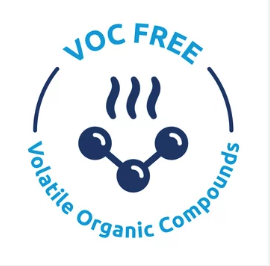Volatile organic compounds (VOCs) are chemicals released into the air as gases from certain solids or liquids.
VOCs are a group of chemicals that are commonly found in many household and industrial products. Some common examples of VOCs include benzene, formaldehyde, and acetone. Exposure to high levels can cause health problems, such as headaches, eye, nose, and throat irritation, and in some cases, more severe issues like cancer.
Sources and Identification
It can be found in a wide variety of products and materials. Some familiar sources include:
- Paints, varnishes, and other coatings
- Adhesives, sealants, and caulking compounds
- Cleaning supplies, such as air fresheners and disinfectants
- Building materials, such as pressed wood and particleboard
- Furniture and other household items made with certain types of foam or synthetic materials
- Automotive products, such as fuels, lubricants, and exhaust emissions
- Personal care products, such as perfumes and hair sprays
- Office equipment, such as printers and copiers
- Industrial processes and activities, such as solvent use and pesticide application
Trees and other plants can naturally form VOCs.
Understanding the Risks of Exposure
Exposure to high VOC levels can adversely affect people living in a home. Some of the potential harms include:
- Respiratory problems: can irritate the eyes, nose, throat, and lungs and aggravate symptoms in people with asthma or other respiratory conditions.
- Headaches and dizziness: can cause headaches, dizziness, and other symptoms of central nervous system depression.
- Cancer: Long-term exposure has been linked to increased cancer risk.
- Liver and kidney damage: Exposure to high levels can damage the liver and kidneys.
- Allergic reactions: Some people may be allergic to certain VOCs, such as contact dermatitis.
It can also damage the home’s indoor air quality and can be harmful to pets and indoor plants.
It is recommended to ventilate the house frequently and uses low-VOC emitting products to reduce exposure.
Detecting (VOCs) in the Air: Methods and Techniques
Several methods detect volatile organic compounds in a home or other indoor space air. Some standard techniques include:
- Passive samplers: These devices can be placed in a room to collect VOCs. Usually, several days to a week, then be sent to a laboratory for analysis.
- Active samplers: These devices use a pump to pull air through a filter or adsorbent material, which collects the VOCs. They can be used to take a snapshot of the air quality at a specific point in time.
- Gas analyzers: These instruments can measure the concentrations of specific VOCs in the air in real time. They can identify which are present and in what concentrations.
- Bio-indicator: Some plants are sensitive to certain VOCs; they can detect their presence in the air by observing the plant’s reaction.
- Sensors: Some companies have developed sensors that can detect VOC in the air; these are becoming more popular and available for personal use.
It is important to note that detecting VOCs in the air does not necessarily indicate a health hazard; it is essential to evaluate the levels and the duration of exposure to determine if there is a risk to human health.
Finding Professional Help
Several professionals can help to address the risks associated with exposure to volatile organic compounds (VOCs) in the home.
- Indoor air quality (IAQ) consultants: evaluate and improve buildings’ air quality. They can conduct air quality testing and recommend reducing exposure to VOCs and other pollutants.
- Environmental engineers: have expertise in environmental pollution and can help to identify sources of VOCs and develop strategies for reducing exposure.
- Industrial hygienists: identify and evaluate workplace hazards, including exposure to VOCs. They can conduct air quality testing and make recommendations for reducing exposure.
- Remediation contractors: specialized in cleaning and decontaminating buildings and can help to remove VOCs and other pollutants from the air and surfaces.
- Building contractors and architects: can help design and construct new buildings that minimize exposure to VOCs and can also help to improve existing buildings to improve indoor air quality.
It’s essential to consult a professional if you suspect your home has high levels of VOCs; it’s advisable to do a professional air quality test and, if needed, hire a professional to perform remediation.
Strategies for a Healthier Home and Environment
- Limiting exposure to traffic: Limiting exposure to traffic by choosing routes that minimize exposure or using public transportation can reduce vulnerability.
- Avoiding industrial areas: Certain industrial activities can release VOC into the air. Avoiding areas near these activities, such as refineries or chemical plants, can help to reduce exposure.
- Planting trees and vegetation: Trees and other plants can act as natural filters for VOCs and other pollutants in the air. Planting trees and vegetation in urban areas can help to improve air quality.
- Supporting regulations: VOC regulations are in place to control the release of VOCs from many industrial activities. Keeping rules and laws limiting VOC release can reduce exposure on a larger scale.
It’s important to note that VOCs are a complex class of pollutants, and the best strategy will depend on the specific VOCs present and the activity that is emitting them. It’s advisable to consult an expert in the field to understand the situation better and propose the appropriate solution.




